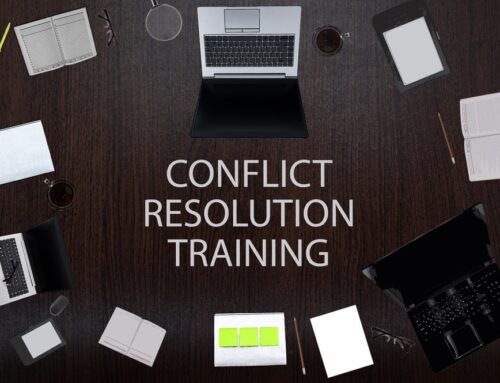Managers deal with workplace conflicts every day. One of the main tasks of a manager is to find solutions to workplace disputes among employees on the same team. Most of your conflict management work as a manager does not directly involve mediating conflict, though.
Instead, you lay ground rules for workflow and workplace etiquette in an effort to create a company culture where two employees can remain calm, even when one of the co-workers disagrees with the other party. Even if you have superhuman interpersonal skills, it is not possible to prevent all workplace tensions.
Therefore, it is useful for managers to learn mediation skills in case they must resort to mediation in order to manage conflict.
When Is Mediating Conflict an Appropriate Solution to Workplace Conflict?
Mediation is often an appropriate approach to dispute resolution if the people involved in the disagreement are in similar roles, so there is a balance of power between them.
It is also a good idea to try mediation when the two coworkers have not been able to resolve the problem on their own, and each seems to be assigning blame to the other. When you get two employees together for mediation sessions, they may be able to reach the same page by talking to each other in front of a neutral mediator.
When Are Other Methods of Conflict Resolution More Appropriate for the Parties Involved?
It is not advisable for the HR department to send employees to mediation if one employee has complained to HR that another employee has been harassing or bullying her. In cases of bullying, the bullied employee might feel like the mediator is pressuring him or her into saying that the problem is resolved when it is not.
Going through mediation and then going back to work as normal might have the same effect as if the bullying is left unchecked. If one employee does not feel safe in the presence of another because of specific actions by the bullying employee, you should not force the two coworkers to face each other in mediation.
Mediation is appropriate when the conflict in the workplace does not clearly involve an aggressor and a victim. It is best when the conflict is not entirely the fault of one person and where it would be inappropriate to impose disciplinary action against one person while enabling the other to go on with his or her job without consequences.

How the Mediation Process Works
The purpose of mediation is to encourage communication and build trust among parties and to put the responsibility for resolving the problem on the parties themselves. The idea is that, by requiring people to discuss their disagreements in a respectful way, you can get each of the participants to see the other’s perspective.
The role of the mediator is to establish a respectful environment. The parties lead the discussion, not the mediator, once things get started.
The mediator’s efforts are spent ensuring that the parties listen to each other and that they address the problem directly instead of making personal attacks or bringing up irrelevant issues in order to distract from difficult conversations. The mediator may interject possible solutions, but the solution to the disagreement is ultimately up to the staff members themselves.
Mediation consists of six steps. If it proceeds successfully from beginning to end, the parties can resolve their disagreements and find common ground.
-
Preliminary Steps
The first step in mediation is to establish the rules and guidelines for the mediation process. The participants may feel, at this stage, that the process has not yet begun, but from the mediator’s perspective, the first step is one of the most important parts of the process. It is how the mediator leads the way toward the participants resolving their disagreement.
You might send an email to the parties outlining how mediation works, what will be happening at the sessions, and a list of dos and don’ts. Whether or not you send a preliminary email, you should also meet with both parties in person. During this meeting, you should not discuss the problem directly; save that for the individual and joint sessions.
-
Individual Meetings
The next step is to meet with each party individually and talk to them about the issues in detail. Even more importantly, you should listen carefully without interruption while the party to the dispute tells you the whole story from his or her perspective. Encourage the person to elaborate on the problem and on how he or she feels about it.
There is no need for the person to stay calm during the individual meeting. These sessions are the appropriate time for the employees involved in the conflicts to show their emotions in an unfiltered way. Once they know that you will listen and that you will give them a chance to say what they want to say, they will trust you more and be more invested in the mediation process. Furthermore, you have a chance to hear all the facts from more than one perspective.
-
Joint Meetings With All of the Parties Involved
You might be used to high-conflict work environments, but the joint mediation sessions are where you can really put your dispute-resolution skills to the test. Once the feuding coworkers are together in the same room, it is time to address the problems directly.
Your role in mediating is not to disclose what either worker told you about their disputes during the individual meeting; those meetings were confidential. Instead, you should make sure that the participants focus on the problem instead of devolving into personal attacks and that they listen to each other instead of talking over each other.
It is important not to rush through mediation. During the first joint session, do not worry about finding a way to solve the problem.
It might even take more than one session just to figure out what the root of the problem is. If you are too hasty in moving to the solution phase, then the team will soon be plagued with new conflicts. The purpose of the first joint session is to lay out all of the facts.
-
Proposing Solutions
Solutions to the problem are not the focus of the first joint session, and it might take much longer than that before either party is willing to propose a change to his or her own actions. For example, you might even want to meet with each party individually after a few joint sessions when you think it is time to start discussing resolutions to the disputes.
When you reconvene to talk about solutions, you should not be the first one to suggest a solution. Remind the colleagues that they have solved problems as a team in the past and that anything that anyone suggests during this session is just an idea. Emphasize that the important thing at this stage is just to listen and not necessarily to agree.
Once the suggestions start flowing, you can fine-tune them to bring each party’s vision of resolution closer to the other party’s vision. Once you have agreed on a solution as a team, you are ready to implement it.
-
Signing a Written Agreement
Whether your company requires it or not, it is a good idea for the parties to sign a written statement once they have agreed on what each will do to remedy the problem. The provisions of the agreement should be specific and actionable. Neither party should promise in writing to do the impossible.
-
Debriefing With the Parties Individually
After the coworkers have agreed to a solution, you should follow up with them individually. Ask them how well mediation and the resulting agreement helped them resolve their disputes. Ask them to give you an example of something they still need help with.

How to Learn More About Workplace Mediation
Workplace leaders can benefit from learning to mediate conflicts among the workers in their organizations. Conflict resolution training, including mediation training, can help you make your organization more productive and make it a more pleasant place to work.
Training courses are available to help you learn to be a leader in conflict management and to mediate specific conflicts among your team members. Resolve Conflict Resolution Training offers courses in person or online, and you can find courses geared toward your industry. Contact Resolve today to get started meditating challenging conflicts in your workplace!









